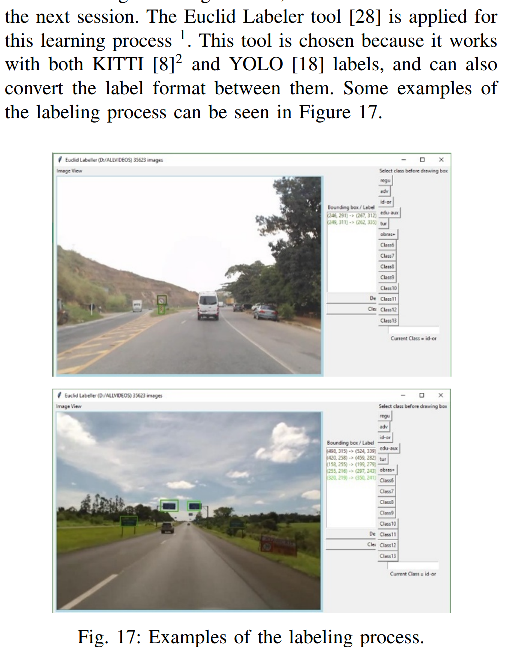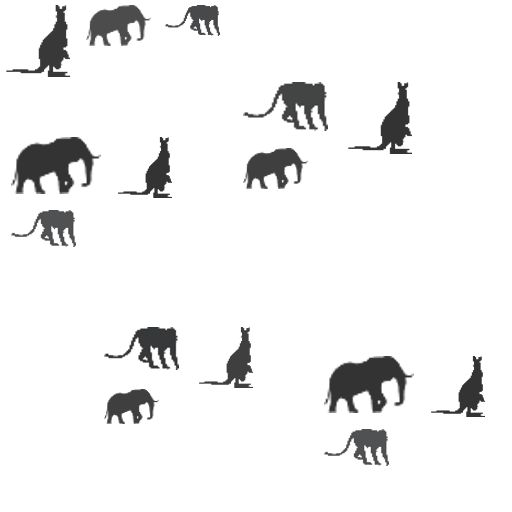Euclid object labeller for object detection training purposes based on Python. Tested on Linux, Windows, and Mac.
- Supports Kitti format
- Supports Yolo annotation format used in labelling, in the darknet framework (Generates bounding boxes, as well as training list file)
- Supports PascalVOC format (XML tree)
- Autolabelling (euclidaug is the augmentation tool, refer section below)
Dynamic selection of format is now supported.
Optimised box selection using keyboard shortcuts.
Example output from the IEEE paper "On the Applicability of Deep Learning for Road Signal Recognition", by Vinicios R. Soares, Mathias R. Luz, Afonso H. Ribeiro, Rafael S. Rbeiro, Marcella S. R. Martins, Max M. D. Santos, and Joaquim de Mira https://ieeexplore.ieee.org/stamp/stamp.jsp?tp=&arnumber=8627071
Create a folder containing the images
- Ensure images are of uniform (not too big) shape using a command for resize like below. (Linux)
Resize all jpg images to 256x256, rename to sz-256-.jpg
for file in *.jpg; do convert $file -resize 256x256 sz-256-$file; done
-
$python euclid.py -
Select the folder containing the images
-
Euclid will show the first image in the folder.
-
Select the class ID, and start labelling. Once done for this image, move to the next image, till all imagea are done.
-
Euclid also generates a supplementary file "train.txt", containing the class ID and full path of training file. This can be used in YOLO format training.
Refer below link for YOLO training and detection on Linux and Windows.
https://github.com/prabindh/darknet
Prebuilt binaries for Yolo are provided at https://github.com/prabindh/yolo-bins
Euclidaug automates the annotation task, so that developers can focus on gathering insights and improving accuracy, than spending time on manual labelling. Combined with AI generated artifical images (like https://generated.photos/), training becomes easy.
Lack of training images reduces training accuracy, when manual annotation is not an option. euclidaug serves to improve availability of training images, specially 2D.
Euclidaug can generate 1000s of precisely annotated/labelled training images in minutes, without manual work.
For an example of auto-annotation of industrial capacitors to detect in a PCB using euclidaug, refer to https://github.com/prabindh/yolo-bins/tree/master/capacito
cd euclidaug
pip install -r requirements.txt
Random scaling, random packing, and random blending - are the operations performed on the images
To significantly augment availability of annotated data (# of images), specially 2D shapes for object recognition. Targeted for Yolo, SqueezeDet, Tensorflow (and others that support KITTI and Yolo formats)
(The images were taken from https://www.freeiconspng.com/img/1075, https://www.freeiconspng.com/img/1065, https://www.freeiconspng.com/img/1052)
Assuming euclid is cloned at c:\xxx, run the below command:
python euclidaug.py C:\xxx\euclid\euclidaug\sample-objects C:\xxx\euclid\euclidaug\sample-background C:\xxx\euclid\euclidaug\train-sample.txt
After seeing below, the augmented outputs will be generated in out_images and out_labels.
Info: Added [3] object images, Max obj/class of [1] Info: Added [1] base images Info: Beginning [11] images @ 0.421875 (sec) ........... Info: Completed @ 0.265625 (sec)
How to run adding new classes:
-
Place all object png images in a directory organised by IDs (for 3 classes, folders should be named as 0,1,2)
-
Place all background png images in a folder (can be any name)
-
Update cfgWidth, cfgHeight, numClasses, and Alpha/scale configurations - in the script, to match the framework requirements
-
Invoke this script as "python <script> "
-
output image files will be written to 'output-images' and 'output-labels' and training list file will be written
-
Note: The labels are in Yolo format, and output image files will be of same resolution as that of the "background" images.
Python 2.7
pip install pillow
pip install image
Python 3
Python 3 + Pillow on Ubuntu, do the below
sudo apt-get install python-imaging-tk
sudo apt-get install python3-pil.imagetk
After labelling the images, the labels can be read and converted to TFRecord using Python scripts available in Tensorflow, using tf.train.Example and tf.train.Features. Note: Yolo and TF share the same bounding box notations (normalised).
Use the function "write2Kitti" instead of "write2Yolo"
https://github.com/dpogosov/yolo_kfm
https://github.com/VanitarNordic
https://github.com/lesterlo (DetectNet with Nvidia)
among others

